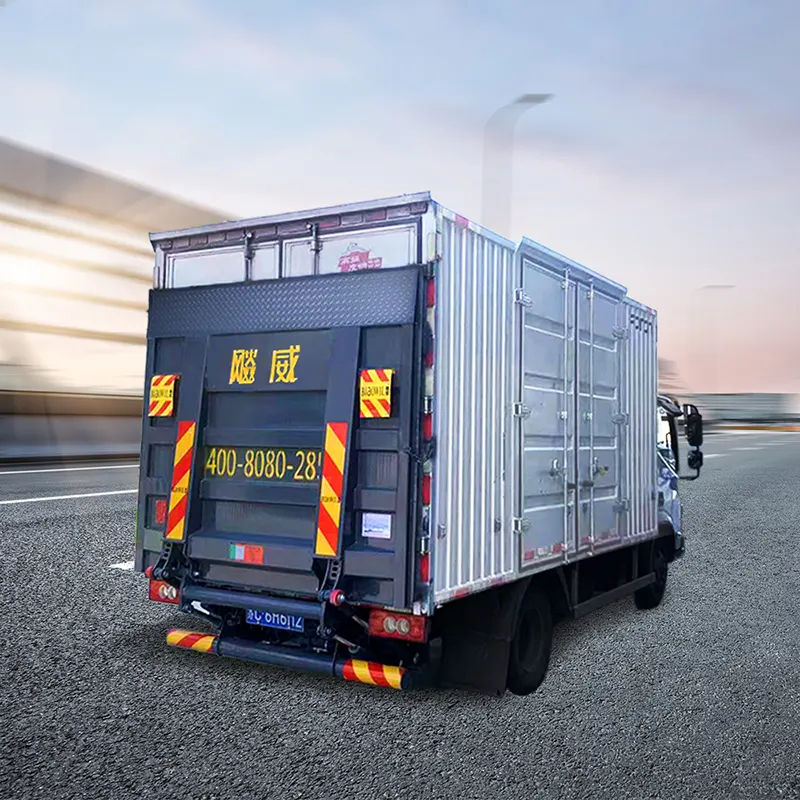Quels sont les différents types de relevés de queue?
Ascenseurs de queue (ou liftels) Les dispositifs mécaniques sont-ils utilisés à l'arrière des camions ou des fourgonnettes pour aider à charger et à décharger des produits lourds en les soulevant au niveau du lit de camion. Il existe plusieurs types de levés de queue conçus pour des applications spécifiques, en fonction de leur capacité de levage, fonctionnalité, et installation. Here are the main types:
- Hayon élévateur en porte-à-faux
Description: The platform is attached to a folding arm, and the entire platform moves up and down in a horizontal position.
Common Use: Ideal for large trucks and heavy loads. They can also tilt, making them useful for moving goods on slopes.
Avantages: Versatile, suitable for various loads, and can double as a rear door.
Disadvantages: Requires a large amount of space at the rear of the vehicle. - Column (Column-Boom) Hayon élévateur
Description: Operates on a vertical rail system mounted on the back of the truck. The platform moves up and down along the rails.
Common Use: Popular with delivery trucks and smaller vans, often used for lower lifting capacities.
Avantages: Simple design, suitable for vehicles with smaller payloads, and doesn’t take much space.
Disadvantages: Limited in platform size and load capacity compared to cantilever lifts. - Hayon élévateur escamotable
Description: Folds away underneath the vehicle when not in use, keeping the rear of the vehicle clear.
Common Use: Widely used in delivery vehicles where quick and easy access to the truck’s rear is needed.
Avantages: Saves space when not in use, lightweight, and allows access to the rear doors without deploying the lift.
Disadvantages: Lower load capacity compared to cantilever or column lifts, and the platform size may be smaller. - Slider (Retractable) Hayon élévateur
Description: The platform slides out from under the vehicle and retracts when not in use.
Common Use: Frequently used in urban delivery vehicles where space constraints may be an issue.
Avantages: Allows for unobstructed access to the rear doors when the lift is retracted. Often used on vehicles with restricted rear overhang.
Disadvantages: More complex mechanism can require more maintenance, and the platform size may be limited. - Column Fold-Away Tail Lift
Description: A hybrid of the column and tuckaway types, this lift folds away when not in use, but it operates vertically on a rail system when deployed.
Common Use: Used in smaller delivery vehicles where space and weight efficiency is important.
Avantages: Combines the benefits of column and tuckaway lifts, offering better flexibility.
Disadvantages: Similar limitations in load capacity and platform size as column and tuckaway lifts.
Common Use: Used in smaller utility vehicles and light commercial vehicles for lifting loads such as heavy machinery or construction materials.
Avantages: Compact and easy to install on smaller vehicles.
Disadvantages: Limited load capacity compared to larger vehicle lifts.
- Railgate Lift
Description: Similar to the column lift but designed with a heavy-duty rail system and a larger platform. It supports higher weight loads and offers more robust stability.
Common Use: Ideal for large, bulky loads or palletized cargo.
Avantages: Heavy-duty, high-capacity, and stable platform.
Disadvantages: More expensive and complex, requiring larger vehicles with sufficient space.
Each type of tail lift has specific applications based on vehicle type, load requirements, and operational environment. The choice depends on the nature of the goods, vehicle size, and frequency of use.
